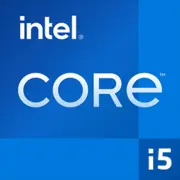Intel Core i5-1140G7

Intel Core i5-1140G7: A Balance of Mobility and Performance in 2025 Ultrathin Laptops
(Relevant as of April 2025)
Architecture and Technology Process: 10 nm SuperFin and Willow Cove
The Intel Core i5-1140G7 processor, released in 2021, remains a popular choice for budget ultrathin laptops. Its Tiger Lake architecture is built on the 10-nanometer SuperFin technology, which marked an important step for Intel in the quest for energy efficiency.
- Cores and Threads: 4 cores and 8 threads thanks to Hyper-Threading. Base frequency — 1.8 GHz, maximum in turbo mode — 4.2 GHz.
- CPU Features: Willow Cove cores brought a 15-20% improvement in IPC (instructions per clock) compared to Ice Lake (10th generation). This is especially noticeable in single-threaded tasks.
- Integrated Graphics: Iris Xe with 80 EU (Execution Units) — twice as many as the previous generation UHD Graphics. Supports DirectX 12, HDMI 2.0, and DisplayPort 1.4.
In comparison, by 2025 Intel shifted to the Intel 4 (7 nm) process with Meteor Lake, but the i5-1140G7 remains relevant due to the low cost of devices built on it.
Power Consumption and TDP: 7–15 W for Thin Laptops
The processor's TDP is 7–15 W, allowing it to be used in ultrathin laptops without active cooling or with compact coolers.
- Operating Modes: Laptop manufacturers can configure the TDP via cTDP (Configurable TDP). For example, in 15 W mode, the system maintains high performance for longer, while at 7 W, it extends battery life.
- Heat Dissipation: Even under load, the chip rarely heats up above 75°C, but in compact cases (for instance, Acer Swift 5), throttling can occur after 10–15 minutes of video rendering.
Performance: From Office Tasks to Casual Gaming
Office Tasks:
- Running 30+ tabs in Chrome, Excel with macros, Zoom + Slack — the processor handles it without lag. In the PCMark 10 test, it scores around 4500 points, comparable to the Ryzen 5 5500U.
Multimedia:
- Converting 4K video in HandBrake: A 10-minute clip takes about 22 minutes to process. In comparison, the Apple M1 does it in 15 minutes.
- Photo editing in Lightroom: Filters and retouching are applied smoothly, but working with RAW files exceeding 45 MP may cause slowdowns.
Gaming:
- Iris Xe runs CS:GO at medium settings (Full HD, 60 FPS), Dota 2 at 50–55 FPS. In GTA V (720p, low settings) — stable 40 FPS. For Fortnite, resolution will need to be lowered to 1600×900.
Turbo Boost Mode:
- The maximum frequency of 4.2 GHz is activated during short tasks (e.g., opening a heavy PDF). In the Cinebench R23 benchmark, the single-threaded score is 1325 points, while the multi-threaded score is 4860.
Use Cases: Who is the i5-1140G7 Suitable For?
1. Students and Office Workers: Attending lectures, working with documents, video conferencing.
2. Digital Nomads: A lightweight laptop (starting from 1.2 kg) with 8+ hours of battery life.
3. Casual Gamers: Games like Minecraft or Overwatch 2 on low settings.
Not Suitable For:
- Video editors working with 8K content.
- Streamers — insufficient cores for simultaneous gaming and broadcasting.
Battery Life: Up to 12 Hours in Reading Mode
Average working time for laptops with the i5-1140G7 (e.g., Lenovo Yoga 7i):
- Web browsing: 9–10 hours.
- Video (1080p): 12 hours.
- Gaming: 2–3 hours.
Power Saving Technologies:
- Intel Dynamic Tuning 2.0: Adapts the TDP based on load.
- Speed Shift: Quickly switches between P-states to save charge.
Comparison with Competitors
1. AMD Ryzen 5 5500U (Zen 2):
- Pros: 6 cores, better in multi-threaded tasks.
- Cons: Weaker iGPU (Vega 7 vs. Iris Xe).
2. Apple M1:
- Pros: Twice the battery life, faster rendering.
- Cons: Limited compatibility with Windows applications.
3. Intel Core i5-1135G7:
- Almost identical to 1140G7, but with fewer EU in graphics (80 vs. 96).
Pros and Cons
Strengths:
- Best-in-class integrated graphics.
- High single-threaded performance.
- Support for Thunderbolt 4 and Wi-Fi 6.
Weaknesses:
- Only 4 cores — multitasking is limited.
- In 2025, it looks outdated compared to the Ryzen 5 7540U (Zen 4).
Recommendations for Choosing a Laptop
- Device Type: Ultrabook (e.g., Dell XPS 13 or HP Spectre x360).
- Price Range: $600–$900 for new models.
- What to Look For:
- Screen: IPS matrix with 300 nits brightness.
- RAM: At least 16 GB LPDDR4X.
- Storage: 512 GB NVMe SSD.
- Ports: 2× Thunderbolt 4 for connecting external GPUs.
Final Conclusion
The Intel Core i5-1140G7 is an optimal choice for those seeking an affordable ultrabook that balances performance and battery life. In 2025, it should be considered if:
- The budget is limited to $700–800.
- A lightweight laptop is needed for study or travel.
- Compatibility with Windows software and peripherals is required.
Key Benefits: Powerful graphics for the class, portability, support for modern interfaces. However, for professional tasks, it’s better to look into the newer generations of Intel Core Ultra or Ryzen 7000.
Basic
CPU Specifications
Memory Specifications
GPU Specifications
Miscellaneous
Benchmarks
Compared to Other CPU
Share in social media
Or Link To Us
<a href="https://cputronic.com/cpu/intel-core-i5-1140g7" target="_blank">Intel Core i5-1140G7</a>